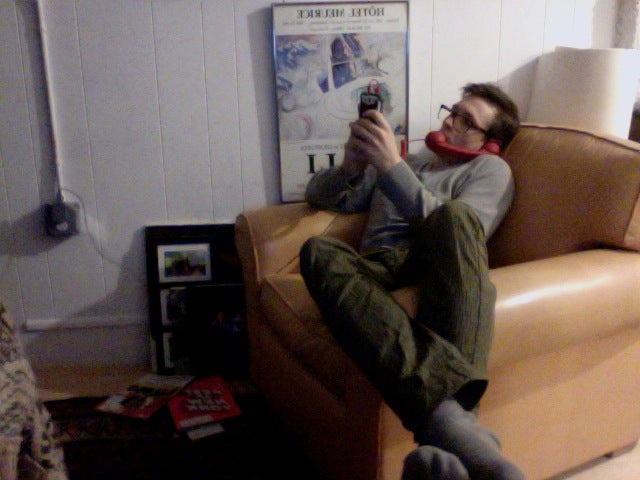
At some point during the sold-out Ryuichi Sakamoto and Alva Noto U.S. premiere of their composition “s,” at the Metropolitan Museum of Art Wednesday night, I had to wonder: how many people are asleep right now? Sure it was a Red Bull Music Academy event, but not a caffeinated can was in sight. Not that the multimedia performance by the cult-followed, internationally renowned duo inspired boredom or even placidity. But there was a certain kind of hypnosis to Sakamoto’s spare, chilling piano arrangements paired with the glitched-out dub-beat bliss of Alva Noto, a.k.a. Carsten Nicolai. While many in the packed Grace Rainey Rogers Auditorium (off the Egyptian wing of the Museum) lulled back in their seats, the coordinated flash-and-bang of the visuals kept others’ eyes locked in. To others, simply seeing these two expats in the flesh was all that mattered—even if they had to elbow their dates to keep them awake.
Argentina-based composer and sound artist Nicolas Melmann opened with a performance of cracked turntable-ism forced through synths, pitting organic samples against digital processing and live instruments. He opened with a sample of Rebekah Del Rio’s “Llorando” from David Lynch’s Mulholland Drive, a piece so reminiscent that it’s hard to disassociate its context from its sound. But actually hearing the song inside a large auditorium spurred a wakeful dream state I’m sure Lynch would be happy with. Melmann’s set inspired this kind of somnambulism, each piece of his composition like wandering from tableau to tableau of referential soundscapes. At one point, harp arpeggios weaved in and out of one another among springy, delayed synths, like the ribbons of a maypole weaving into sound; at another, samples of frogs and crickets undercut a docile, sky-high bleep, giving the feeling of spotting a blinking satellite cruising overhead a chirping meadow at night. These overt references to external situations reached a pretty heavy-handed climax with a Proustian spoken-word clip that quoted, in part “remembrance of things past,” a work so tied to the senses it’s almost overbearing.
If Melmann’s sounds were meant to transport the listener to situations external to the auditorium, Nicolai and Sakamoto turned the lens completely inward. The composition they performed, “s”, is a A/V concept work focused around electronic music as the sturm und drang of the future of composition. The music was unique enough to became virtually removed from the situation, with Sakamoto’s melodies so close in harmony and chords so delicate it becomes hard to parse anything recognizable whatsoever. This music is so singular to itself that it sounds absent of time and place, directing the listener in a way opposite to Melmann’s—the focus became on the impressions left.
Sakamoto’s anti-melodies danced around the cliché, as he bowed over his miked-up Yamaha concert grand, faintly taking cues from Nicolai, who stood behind a few pads and a laptop. It was a broadly professional performance, with not a single slip-up to account for. The most astounding moments were when Sakamoto seemed to try and mimic the white-noise capabilities of Nicolai’s sound fields, attempting to account for the piano’s place in history The most astounding was when he stood and played from completely inside the instrument, plucking strings, hitting clave, and whacking parts of the piano with mallets—this caused audible fear in the person sitting to my right. More throbbing, beat-driven accessible pieces, such as “pioneer IOO” and “Aurora” received welcome applause, which continued after every movement following the fourth. There was a definite arc to the performance, starting simply and delicately, showing conflict, attempting resolution, and ending in a roar. On the closing piece, “Naono,” fields of Nicolai’s white noise battled a furious Sakamoto, running up and down the piano.
At the very basic level, it was astounding to hear Nicolai’s totally synthetic soundfields of scuzz and throbbing bass on large speakers. Though the five Alva Noto + Ryuichi Sakamoto albums on the market are excellent in headphones, there is absolutely no match to feeling the low-register roar of a pitch-bent bass roar through theater seats. He’s an acclaimed DJ, but in the sit-down setting of the auditorium, it spoke to a kind of high-low battle that speaks to the theme of the performance (so did their T-shirts paired with tuxedo jackets). Sakamoto is one of the founders of pioneering Japanese electronic pop act Yellow Magic Orchestra and remains one of the most prolific composers of this day, having won a Grammy, multiple Golden Globes, and an Academy Award. Alva Noto is one of the founders of the acclaimed German Raster-Noton label and a pioneer of the blip-bleep-roar of glitch music, the sounds of which James Blake’s odder palette owes some credit.
It felt like a concert from Gattaca or The Fifth Element, a bourgeois virtuosic setting for two artists talented beyond the scope of their prime. There’s almost no use in trying to explain the feeling of this performance in words—it was largely inexpressible. But the visuals brought a better understanding. They were fascinating, low-res projections, reminiscent of Windows ‘95 screen savers and totally indicative of the music. It began with what could be seen as a musical staff, five lines across the length of the stage, throbbing with the synths. But instead of populating with musical notation, sound waves linked to the notes Sakamoto played on the piano appeared across the screen. It became indicative of the written/rote battle that’s become associated with a lack of classical music understanding in the electronic field. The wobbling roundness of the organic instrument, paired with the martial square throb of the synth illustrated a dichotomy of instrument that’s nothing if not representative of a stance. A deaf person could have heard the message of this show, loud and clear—while the organic and synthetic look great together, there’s never a replacement for the “real.”

